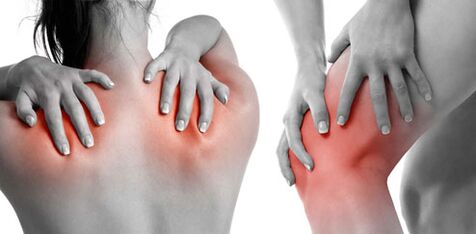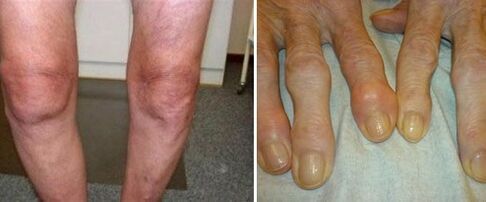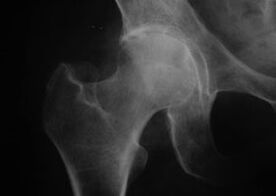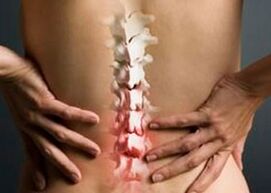
Joint pain can make life unbearable.After the visit, a diagnosis of joint or arthritis will appear on the outpatient card.
People who stay away from medicine know little about the difference between arthritis and joint disease and mistakenly believe that they are the same disease.
In fact, these are two completely different pathological processes that can occur simultaneously.
Arthropathy
Arthropathy refers to a degenerative inflammatory process that occurs due to age-related changes in the structure of cartilage tissue.
It affects the moving joints of the large bones and, less commonly, the finger joints.
Appearance of joints with arthropathy

The main cause of pathological changes is disorders of cartilage metabolism.Violation of cartilage nutrition leads to irreversible loss of proteoglycans and loss of tissue elasticity.
Dystrophic changes in cartilage cause pathological changes in the surface structure of bone and joints.Over time, the degenerative process spreads to the tissues surrounding the joint.
Types of Arthropathy
Depending on their origin, they differentiate between primary and secondary arthropathy.
The main form affects previously healthy joints and is the result of age-related changes and lack of physical activity.The time when the first symptoms of arthropathy appear depends on genetic predisposition, characteristics of occupational activity and lifestyle.
Traditionally, people over 45 have been considered at risk, but there is now a steady trend towards earlier onset of the disease.The disease mainly affects women, but the dependence on sex fades with age.
Secondary arthropathy occurs in the context of a previous injury or some disease of a different nature, including:
- autoimmune processes;
- Metabolic disorders;
- endocrine dysfunction;
- pathology of bone and joint structures;
- genetic diseases;
- inflammatory process.
Secondary arthropathy is not related to the aging process and can occur at any age.
The disease develops in three stages.
In the first stage, changes occur in the joint fluid.The nutrition of cartilage is destroyed and its resistance to stress decreases.The surface of the cartilage becomes rough, inflamed, and accompanied by pain.
When the disease progresses to the second stage, the pain becomes habitual and the accompanying inflammatory process becomes wave-like.The cartilage begins to degenerate and compensatory bone growth develops at the edges of the joint area.Periarticular muscles are involved in pathological processes.
The third stage is characterized by severe loss of articular cartilage and complete destruction of regional tissue.Degenerative processes result in irreversible anatomical changes, including changes in the limb axis.The function of the ligamentous apparatus is disrupted and the affected joint moves abnormally with limited natural movement.
According to the location of the disease, it can be divided into:
- knee joint disease,
- hip joint disease,
- spondyloarthropathy,
- Arthropathy of the interphalangeal joints of the hands.
Other pathological localizations are relatively rare.
knee joint disease, knee joint disease
Risk factors for developing this disease include genetic predisposition, knee injuries caused by overuse or occupational characteristics.
According to statistics, arthropathy of the knee joint is more common in women.
In the early stages of development, the disease manifests itself as discomfort and soreness in the affected joints.Depending on the cause of the lesion, several forms of knee arthropathy can be distinguished.
Some of them are characterized by a long-term lack of progression; patients' conditions remain stable for decades.However, some develop rapidly and cause loss of mobility in the affected limb.
hip arthropathy, hip arthrosis

With this disease, typical clinical manifestations of arthropathy can be observed.
The first symptom of hip arthritis is discomfort in the hip joint after physical activity.
With progressive hip arthritis comes increased pain, stiffness, and limited mobility.
Patients with severe hip disease should protect the affected limb, avoid stepping on it, and choose a position that minimizes pain while at rest.
spondyloarthropathy, spondyloarthropathy

Spondyloarthropathies refer to pathologies that occur in the context of degenerative processes of the intervertebral discs.
The first and main symptom of spondyloarthropathy is pain when bending side to side or front to back.
The pain gradually decreases when a person assumes a horizontal position.
Over time, without adequate treatment, there may be a complete loss of mobility in the affected part of the spine.
Without proper treatment, spondyloarthropathy can cause intervertebral hernias and joint deformities.In severe cases, patients can lose the ability to perform daily activities and become disabled.
Arthropathy of the interphalangeal joints of the hands
This disease mainly affects women.Early symptoms of joint disease include pain when touching cold water and straining your fingers.Over time, joints become deformed due to the compaction of adjacent tissue and the development of characteristic bone growth.
The course of the disease is wave-like, with joint swelling in the acute phase, partial loss of mobility, and possible impairment of touch.
Treatment of Arthropathy
Modern medicine cannot completely cure joint disease.However, prompt diagnosis and comprehensive treatment aimed at preventing further destruction of cartilage tissue can help stabilize the condition of the affected joint and significantly improve the patient's quality of life.
First, the load on the musculoskeletal system needs to be reduced.Doctors recommend avoiding carrying heavy objects, staying in one position for long periods of time and limiting the amount of time you spend walking on your feet.Losing weight is crucial for overweight patients.
In the pharmacotherapy of arthropathy, the following drugs are used:
- Nonsteroidal anti-inflammatory drugs are available as injections or tablets for internal use and as part of an ointment for topical use.Prescribe the form and regimen of use according to the patient's condition;
- Medicaments of the chondroprotectant group used to maintain the condition of cartilage tissue;
- Steroid anti-inflammatory drugs in the form of intra-articular injections.If the condition is serious, follow the doctor’s advice;
- Hyaluronic acid preparations improve joint mobility.
In addition, hot compresses and ointments, drugs that activate blood microcirculation and metabolic processes, antioxidants and trace element-vitamin complexes containing selenium are used, as well as physical therapy.In severe cases, surgical intervention is required.
During the remission period, it is recommended that the patient undergo a course of exercise therapy, selected according to the characteristics of the disease course.
arthritis
Arthritis is an inflammatory disease that occurs as a complication of an underlying disease, a concomitant pathology, or a previous infectious disease.
The appearance of arthritic joints

Typical causes of joint inflammatory processes include:
- Metabolic disorders in the body;
- vitamin deficiency;
- Injuried;
- autoimmune diseases;
- Infectious diseases of various causes.
Unlike arthropathy, the pathological process of arthritis affects periarticular tissues.The pain occurs independently of physical activity and body posture and often bothers you at night.
The joint noise characteristic of the early stages of arthrosis is rarely observed.General blood tests reveal the presence of inflammatory processes; when examining joints, characteristic degenerative changes in cartilage are rarely detected.
A common symptom of both diseases is pain.Any unusual and unpleasant sensations in your joints are a good reason to consult your doctor.The success of treatment depends largely on the timely detection and treatment of the disease.
Types of arthritis
Arthritis is divided into several types depending on how it occurs:
- Infectious arthritis.They can develop into separate diseases due to wound infection (primary infectious arthritis) or pathogens entering the bloodstream from infected organs (secondary arthritis);
- Rheumatoid arthritis.This chronic disease is an infectious autoimmune disease that usually occurs in middle-aged and older adults.
- gouty arthritis.Urate crystals formed in the joint capsule cause microdamage to the cartilage surface, initiating an inflammatory process;
- traumatic arthritisOccurs as a reaction to trauma, but can also occur years after its consequences have resolved;
- juvenile rheumatoid arthritisAffects children under 16 years of age.The cause of this disease is unknown.The course of the disease is chronic and progressive.
The course of arthritis can be acute or chronic.In the acute course, the disease develops rapidly, the affected area becomes severely swollen, the pain is severe, and the local or systemic body temperature rises.
With chronic arthritis, symptoms gradually worsen and the condition may persist for years.Acute arthritis can become chronic if not treated promptly or appropriately.
According to the characteristics of the disease, it is divided into monoarthritis and polyarthritis.In monoarthritis, the disease is limited to one of the joints; when multiple joints are involved in the pathological process, polyarthritis is diagnosed.
arthritis treatment
Treatment strategies for arthritis depend on the cause of the disease and the severity of the patient's condition.For infectious arthritis, the patient is prescribed a course of antibiotics or other drugs depending on the nature of the pathogen.
To combat inflammation, NSAIDs are applied topically in the form of injections, tablets, and/or ointments or gels.
In addition, medications such as chondroprotectants, antihistamines, and general restoratives may also be prescribed.In some cases, patients are given medications that improve blood microcirculation.
In addition to medication, patients also receive a range of physical therapy and a range of exercise therapies during remission.
In severe and advanced cases, surgery may be required.
Without expert help, arthritis and joint disease can lead to disability.
Self-medication is contraindicated for joint diseases; in most cases, the patient's condition gradually worsens.
Any change in joint function is a reason to see a doctor.
Precautions
To prevent arthritis and arthritis, it is important to optimize physical activity and avoid overload.People diagnosed with this disease, as well as those at high risk, need to modify their diet to eat more healthy foods, drink less alcohol, and quit smoking.
It is recommended that people prone to obesity maintain a normal weight because increased load on the musculoskeletal system can trigger or accelerate pathological changes.
In order to detect diseases early, it is important to have regular preventive check-ups.

























